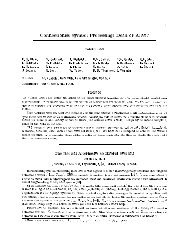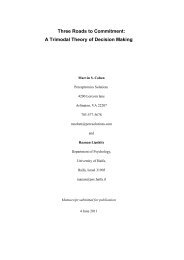Three Roads to Commitment: A Trimodal Theory of Decision Making
Three Roads to Commitment: A Trimodal Theory of Decision Making
Three Roads to Commitment: A Trimodal Theory of Decision Making
Create successful ePaper yourself
Turn your PDF publications into a flip-book with our unique Google optimized e-Paper software.
<strong>Three</strong> <strong>Roads</strong> <strong>to</strong> <strong>Commitment</strong>: A <strong>Trimodal</strong> <strong>Theory</strong> <strong>of</strong> <strong>Decision</strong> <strong>Making</strong> 27<br />
psychology” (Malle, 2004). Cohen et al. (1996, 1998, 2001) generalized this account. They found that when<br />
experienced decision makers are directly responsible for actions (e.g., military commanders), they use a s<strong>to</strong>ry telling<br />
strategy that integrates situation assessment and mental simulation. According <strong>to</strong> the Recognition / Metacognition<br />
theory, the s<strong>to</strong>ry makes sense <strong>of</strong> observations by explaining those that have occurred and predicting new ones (e.g.,<br />
disease C caused observed symp<strong>to</strong>ms S1 and S2; if we test for another symp<strong>to</strong>m <strong>of</strong> C, S3, we will find it as well)<br />
and justifies actions by showing how they will succeed given those explanations (treatment A is appropriate for<br />
disease C, and will be followed by observable patient recovery).<br />
According <strong>to</strong> Penning<strong>to</strong>n & Hastie, s<strong>to</strong>ries enable jurors <strong>to</strong> identify gaps in the explana<strong>to</strong>ry structure – where<br />
additional information is needed or, in its absence, where assumptions might have <strong>to</strong> be made (e.g, test for symp<strong>to</strong>m<br />
S3, or just assume it is there). The Recognition / Metacognition theory generalizes this aspect <strong>of</strong> s<strong>to</strong>ry-telling as<br />
well. Pr<strong>of</strong>icient decision makers identify and correct not only gaps in s<strong>to</strong>ries, but also conflicts (e.g., S3 is tested for<br />
but not observed; A is applied but the patient does not recover) and unreliable assumptions (e.g., some patients do<br />
not respond <strong>to</strong> treatment A even though they have condition C). They attempt <strong>to</strong> correct these problems by<br />
information collection when it is feasible (e.g., testing first <strong>to</strong> see if a patient is the type for whom treatment A<br />
works), or by adjusting assumptions when it is not (e.g., the doc<strong>to</strong>r assumes A will work until she finds that it<br />
doesn’t).<br />
-----------------------------------------------------------<br />
Insert Figure 4 about here<br />
-----------------------------------------------------------<br />
Figure 4 diagrams an example <strong>of</strong> the s<strong>to</strong>ry-building strategy. It shows a temporal sequence <strong>of</strong> TDM cycles and<br />
how the s<strong>to</strong>ry changes within and between them. 12 In Figure 4, fictional Dr. House, M.D., matches a patient’s<br />
12 The example is based on Rudolph’s (2003) experimental research with anesthesiologists. Rudolph studied errorcorrection<br />
performance in a difficult medical scenario, in which initial diagnoses and treatment decisions were<br />
invariably incorrect. She found a strong relationship between problem solving strategies and eventual clinical<br />
success. One group, whom Rudolph describes as fixated, changed treatments after a failure but never changed<br />
diagnoses – no matter how many attempts had been made <strong>to</strong> treat the same ailment (single loop learning only).<br />
Another group utilized an approach she called vagabonding, in which they changed diagnoses after a single failed<br />
treatment attempt (single loop and double loop learning at the same rate). In contrast, the most effective problem<br />
solvers did not abandon a diagnosis after a single treatment failure. They explained away initial treatment failures as<br />
idiosyncratic patient reactions or implementation error. They did change diagnoses after multiple failures – when the<br />
accumulation <strong>of</strong> such assumptions had become less plausible. They combined rapid single-loop learning about




